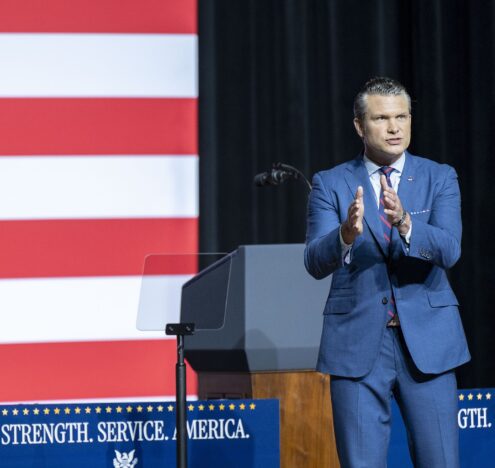On April 1, The Nation magazine published an article with the breathless headline “Exclusive: The Military Knew Years Ago That a Coronavirus Was Coming.” The article went on to highlight some remarkably prescient details from a draft US Northern Command plan for Pandemic Influenza and Infectious Disease Response drafted in January of 2017. It discussed the potential for a flu-like pandemic and shortages of things like ventilators and masks. While the magazine might be forgiven for the attention-grabbing headline — it certainly wasn’t the only one — it does raise some important questions about what it means to “know” something in the intelligence business, what it means to forecast, and what is done to manage risk.
The best way I have seen to think about risk is as an equation an Army general taught me:
Risk = probability of something bad happening × the consequences/ability to manage the consequences
So if something very bad is likely to happen and your ability to deal with it is very low, your risk is high and vice versa. To lower your risk, you invest in the capabilities to deal with bad things. Most of us do this to some degree in our everyday lives. The risk of me dying on any given day is low though increases as I age. The financial consequences to my family if that happens would be severe but also go down over time as my kids become less dependent on my income (God willing). I mitigate this risk by buying life insurance so that my family can deal with the consequences if that bad event, my death, occurs. I have term life insurance that expires when I am 80 because although the probability of my death at that age is fairly high, the financial consequences to my family will be pretty low as they will no longer be dependent on my income so I don’t need to invest much in mitigation efforts to lower the risk. Insurance is by definition a risk mitigation tool.
All of our national security efforts — whether to deal with the threat of terrorism or war with China or a biological attack — can be thought of as risk mitigation strategies or insurance. We think about the most likely things to happen and the worst things that can happen and invest to prepare for them. We also hope that if the threats are man-made, by investing in our capabilities to counter them and demonstrating those capabilities, would-be adversaries will recognize that their ability to impose bad consequences on us may be outweighed by the bad consequences to them and thus be deterred from trying anything nasty. In that way we seek to lower the probability of a bad thing happening in the first place. So we work on both the numerator and the denominator of the equation to lower the overall risk.
Did we spend too much? Who knows? It’s kind of like the garlic I have around keeping away the vampires. Is it worth it? Well thus far my home is vampire-free so it seems to be working.
In my career as an intelligence officer in the US Air Force, I was often asked to make a forecast about what would happen in the future. As much art as science, I tried to avoid making specific predictions but rather sought to bound the possible course of future events and then give some assessment of the probability each event would unfold. I tended to adopt the Army formulation of “most likely and most dangerous.” Tell the commander what you think is most likely to happen and then tell them what’s the worst thing that can happen. It is then the commander’s job to take that information and decide how to mitigate risk. They must prepare for both the most likely and the most dangerous scenarios. And this is where science really goes out the window: since that preparation is subject to preference. Most commanders will commit their resources and efforts to what they believe to be the most likely scenario, which is not always the same one their intelligence officer thinks it is. Many will also leave some resources in reserve in case the worst-case scenario materializes. A good intelligence officer will also develop a collection plan designed to watch the key indicators which would signal which way events are unfolding.
In the national security world, we give a lot of weight to low probability but high consequence events. A nuclear conflict is highly unlikely, but the consequences would be really, really bad, so we invest many billions to deal with this scenario. Often because we don’t know what didn’t happen because of our efforts, we have trouble assessing the value of our investments. We invest a lot in our nuclear deterrent and so far so good. Did we spend too much? Who knows? It’s kind of like the garlic I have around keeping away the vampires. Is it worth it? Well thus far my home is vampire-free so it seems to be working.
In defense planning, you can’t mitigate every risk to the same degree, and so must decide where to invest resources. Do we spend more to deal with terrorism or great power conflict? Obviously a lot more goes into what we spend our defense resources on than just a pure risk calculation but still, our perception of risk is a big driver in where the money gets spent and the tradeoffs that we make.
The question that many are asking now is, “Why didn’t we do more to prepare for a pandemic?” Did we know a pandemic was possible? Even probable? The Northern Command document suggests that we did. Multiple wargames and recorded warnings suggest that we did. President Bush talked about preparing for a flu pandemic in 2005. Did we know that the consequences, if a pandemic occurred, would be bad? It seems that by definition the consequences of pandemics are pretty bad. A few years ago, I asked the head of the Intelligence Advanced Research Project Activity (IARPA) what kept him up at night and he didn’t hesitate to say the biological things scared him the most because they were the hardest to deal with.
So we knew it might happen and we knew it would be bad if it did. Did we invest enough to mitigate our risk? In retrospect, clearly not. We should have invested more in stockpiling critical supplies like masks and ventilators. We should have followed detailed plans that were already on the shelf, laying out who was in charge and what their responsibilities were. Perhaps most importantly, we should have been better attuned to the warning signs in the early days of the pandemic, and we should have snapped into action much sooner. We’re paying a heavy price today for many of these deficiencies. When this is all over there will likely be many investigations and a long list of steps we should have taken and things we should have done will be outlined.
So why didn’t we do these things that seem so obvious now? In some cases, while the consequences were seen as pretty dire, the probabilities of a pandemic like this one occurring were seen by some as low and therefore much investment wasn’t warranted. As I mentioned above, just because the intelligence people think something bad is likely, doesn’t mean the commander or the decision-maker has to agree with them. In other cases the consequences of a pandemic on our healthcare system and our economy weren’t fully appreciated by those in decision-making positions, though some forecasts, such as the one from Northern Command, saw these coming. Additionally, there are outside pressures to address some problems ahead of others. While nuclear war may be improbable, building missiles, submarines and bombers benefits a whole lot of companies and people and they exert pressure on those who make decisions about funding. The military-industrial-congressional complex gets a lot more attention than the pandemic response complex if there even is such a thing.
But some of the lack of preparation can be attributed to tradeoffs we make all the time. We didn’t spend money preparing for this threat, but we did spend money on other things that posed other risks. In the future, we will undoubtedly make a different calculus. When we rack and stack the list of future risks and what we are going to spend on to mitigate them, pandemics will likely rank much higher up because the risks they pose have now become much more real, but that does mean that other things will get pushed down. In addition, while pandemics are clearly a national security problem, dealing with them isn’t just the responsibility of the traditional national security apparatus, agencies like the Department of Defense and the intelligence community. We’ll have to think about shifting some resources to things like public health and disease surveillance and perhaps shifting money from the defense budget to the Department Health and Human Services. We’ll be better prepared for a pandemic but we might have to make some tradeoffs and reduce spending on other things. We can off course just spend more, but resources are always finite and choices will still have to be made.
There are always more risks than you have resources to fully mitigate.
Again to some degree, we do this in our personal lives. If you are picking a health insurance plan do you pick one with low premiums and high deductibles, accepting that you might have to pay a lot out of pocket if you get sick? Or do you pay higher premiums but ensure lower out of pocket costs? It’s sort of pay me now or pay me later and your perception about how much your health is at risk. Ideally, we’d love a low-cost plan with low deductibles that covered everything, but we really can’t have our cake and eat it too. We must choose between the risks we’re willing to take and the resources we’re prepared to expend to mitigate them.
You can always do more to prepare for a long list of bad things that might happen. There is much discussion today about the risks from climate change. How bad are the effects likely to be? How fast will those effects occur? And, perhaps most importantly, how much should we spend now to mitigate those risks? Different groups have different answers to these questions and have different motivations. Some argue for doing a lot and some for very little. Spending more may take away from some other priority. There are always tradeoffs and we’re never going to guess 100% right. Ideally, we’ll be better prepared for the next pandemic, but other things may be threatening us as well. What should we do about them?
Rob Levinson is a retired Lt. Col in the US Air Force with over 20 years of service as an intelligence officer. He is a graduate of the Air Force Academy and served in Latin America, the Middle East and South Korea as an intelligence officer, foreign area officer, commander and politico-military affairs officer.




















